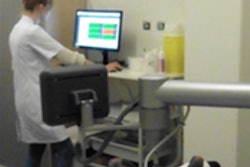Dear Advanced Visualization Insider,
Automated 3D breast ultrasound has become an indispensable adjunct to mammography for women with dense breasts, owing to its ability to find small invasive tumors that mammography can miss. But image quality is highly operator-dependent, and even expert sonographers can turn in images that are hampered by acoustic shadowing and other flaws.
Enter German researchers, who have developed an algorithm to find nondiagnostic image segments on 3D ultrasound in time to fix them before the patient leaves the doctor's office. The new algorithms focus on the shape of the breast to determine any areas of low quality that need to be rescanned. The technique, once optimized, could go a long way toward lowering the high recall rates that make breast ultrasound a chore. Learn more here.
Robot-assisted approaches to radical prostatectomy and dissection of pelvic lymph nodes are becoming more common, but technical problems must be ironed out before widespread clinical implementation starts, said researchers from Leiden University Medical Hospital in the Netherlands. Key to developing successful surgical techniques is the integration of fluorescence guidance technologies and novel radiotracers into the robots. In a new article, the authors investigate preoperative robot-integrated fluorescence laparoscopy using standard settings.
In radiography, a German-Danish firm has upgraded its bone assessment software with a new version that examines four separate bone health parameters. With the study on implementation of the new technique has come new information about changes in bone density over time, the investigators said.
In the U.K., a new liver software package based on MRI aims to cut down on unnecessary biopsies, according to a study from Oxford University. In current practice, clinicians must acquire different kinds of MR images to assess different disease processes in the liver. But the new technique converts multiple quantitative parameters from MRI scans into a single score to determine which patients have disease. Learn how it works here.
Finally, a new study from Italy looks at hard-to-detect flat polyps in CT colonography, assessing the ability of computer-aided detection software to find them. See how the algorithm performed in 200 patients by clicking here.
We invite you to scroll down through the links below for more stories in advanced visualization and 3D imaging -- all right here in your Advanced Visualization Community.



















